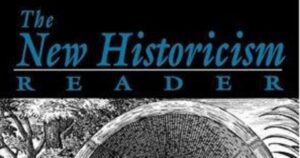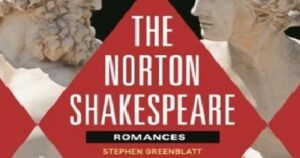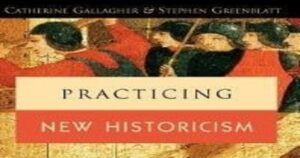New Historicism and 15 Important Concept
New Historicism is a literary theory that emerged in the 1980s, primarily through the work of Stephen Greenblatt, and gained widespread influence in the 1990s. This approach seeks to understand intellectual history through literature and literature through its cultural context, following the 1950s field of history of ideas. It is considered a form of cultural poetics and has become a significant force in literary studies worldwide.
Table of Contents
Emergence of New Historicism:
It was developed from its parent theory of Old Historicism, which views a text within its cultural and historical contexts. However, it sees history as inextricably linked to analyzing literature, whereas Old Historicism viewed it as background to be considered during analysis.
The core principles of New Historicism include:

- History is central to any and all texts.
- All historical factors, including social, economic, and political conditions, must be considered.
- The critic’s historical conditions are relevant, and their biases must be acknowledged.
- Power is a key consideration, and how it manifests in an author’s writing is crucial.
- Nuance is key, and history is ever-changing.
Central figures of New Historicism:
- Stephen Greenblatt: An American literary theorist specializing in William Shakespeare, Greenblatt is attributed to founding the field of New Historicism. His work “The Power of Forms in the English Renaissance” (1982) provides an example of a New Historicist analysis of a text.
- Harold Aram Veeser: An American university professor and literary theorist, Veeser is known for his contributions to both New Historicism and Postcolonial theory. His work “The New Historicism” (1989) is a central theoretical text in the field.
- Michel Foucault: A French literary theorist, Foucault’s work on power and knowledge has significantly influenced New Historicism.
Writers associated with New Historicism along with their notable works:

- Stephen Greenblatt:
- “The Power of Forms in the English Renaissance” (1982)
- “Renaissance Self-Fashioning” (1980)
- “Learning to Curse” (2007)
- Harold Aram Veeser:
- “The New Historicism” (1989)
- Michel Foucault:
- “Discipline and Punish” (1975)
- “The History of Sexuality” (1976)
- Lynn Hunt:
- Peter Thornton:
- “Seventeenth-Century Interior Decoration in England, France and Holland” (1978)
- C. L. Barber:
- “Shakespeare’s Festive Comedy” (1959)
- Catherine Gallagher:
- Catherine Gallagher is a literary scholar who, together with Stephen Greenblatt, wrote “Practicing New Historicism” in 2000, a book that explains new historicism and its application in literary analysis.
Stephen Greenblatt:
Stephen Greenblatt is considered one of the founders of this theory, a literary theory that seeks to understand intellectual history through literature and literature through its cultural context. Greenblatt’s work has been instrumental in shaping the field of New Historicism, and his ideas have had a significant impact on literary studies. Some key aspects of Greenblatt’s approach to New Historicism include:
- Cultural Poetics: Greenblatt’s concept of cultural poetics emphasizes the study of literature as a means of understanding the cultural practices and social energies of a particular historical moment.
- New Historicism: Greenblatt’s work helped establish New Historicism as a distinct approach to literary studies, emphasizing the importance of historical context and cultural analysis.
- Power Dynamics: Greenblatt’s work often explores the power dynamics at play in literary texts, examining how literature reflects and shapes social and political relationships.
- Historical Context: Greenblatt emphasizes the importance of understanding the historical context in which literary texts were written and received.
- Literature as a Cultural Artifact: Greenblatt views literature as a cultural artifact that can reveal insights into the beliefs, values, and practices of a particular historical moment.

Some of Greenblatt’s notable works:
- “The Power of Forms in the English Renaissance” (1982)
- “Renaissance Self-Fashioning” (1980)
- “Learning to Curse” (2007)
- “The Norton Shakespeare” (2008) – a collection of Shakespeare’s plays that Greenblatt co-edited.
Greenblatt’s work has been influential in shaping the field of New Historicism, and his ideas continue to be widely studied and debated in literary studies today.
Louis Montrose:
Louis Montrose is a proponent of New Historicism, a literary theory that emerged in the 1980s. Montrose views it as an array of reading practices that investigate the ways texts represent and shape a society’s behavior patterns and cultural codes. He highlights the following key concerns:
- Reciprocal concern with the historicity of texts and the textuality of history
- Rejecting the formalist conception of literature as an autonomous aesthetic order
- Rejecting the reflectionist notion that writing simply mirrors a stable and coherent ideology
- Explaining how texts instantiate practices and codes in readers
- Rethinking the relationship between writing and culture
- Rethinking the ways authors interact with social and linguistic systems
- Exploring the political potential of writing
- Engaging with literary and social theory
Concepts and Literary Terms associated with New Historicism:

- Cultural Poetics: The study of literature as a means of understanding cultural practices and social energies.
- Historical Context: The social, political, and cultural circumstances in which a text was written and received.
- Power Dynamics: The ways in which literature reflects and shapes social and political relationships.
- Self-Fashioning: The process by which individuals create and shape their own identities.
- Rhetoric: The use of language as a means of persuasion and communication.
- Discourse: The language and ideas that shape a particular historical moment.
- Ideology: The beliefs and values that shape a particular culture or society.
- Hegemony: The dominant cultural or political force in a particular historical moment.
- Subversion: The act of challenging or resisting dominant cultural or political forces.
- Intertextuality: The relationships between different texts and cultural artifacts.
- Contextualization: The act of placing a text within its historical and cultural context.
- Historicism: The study of history and culture through literature.
- New Historicism: A specific approach to literary studies that emphasizes historical context and cultural analysis.
- Cultural Artifact: A text or object that reveals insights into a particular culture or historical moment.
These concepts and terms reflect the key concerns of New Historicism, including the importance of historical context, cultural analysis, and power dynamics.
Impact and Criticism
New Historicism has become one of the most influential modern literary theories, encouraging an interdisciplinary approach to literary studies. However, it has faced criticism for its perceived lack of historical sense and its tendency to reject grand narratives.
In conclusion, it offers a nuanced and contextual approach to literary analysis, emphasizing the importance of understanding the historical background of a text. Its emergence and development have been shaped by the work of prominent scholars, and its influence continues to be felt in literary studies today.
Read and learn more: Cultural Studies: Interesting Facts







One thought on “New Historicism and 15 Important Concept”